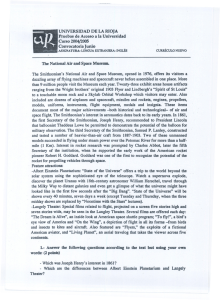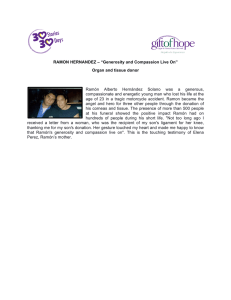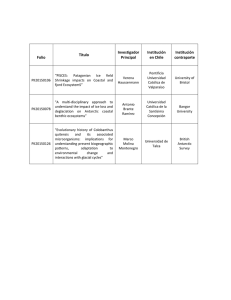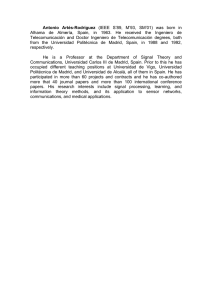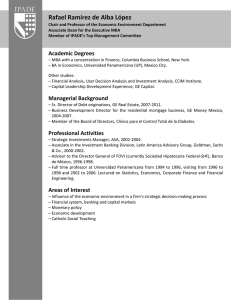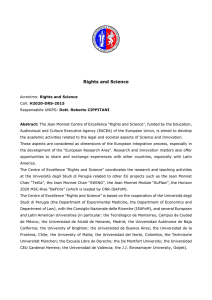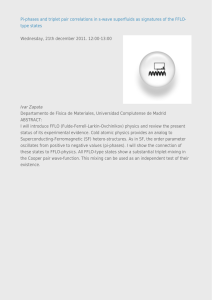Theme, cohesion devices and transiation
Anuncio
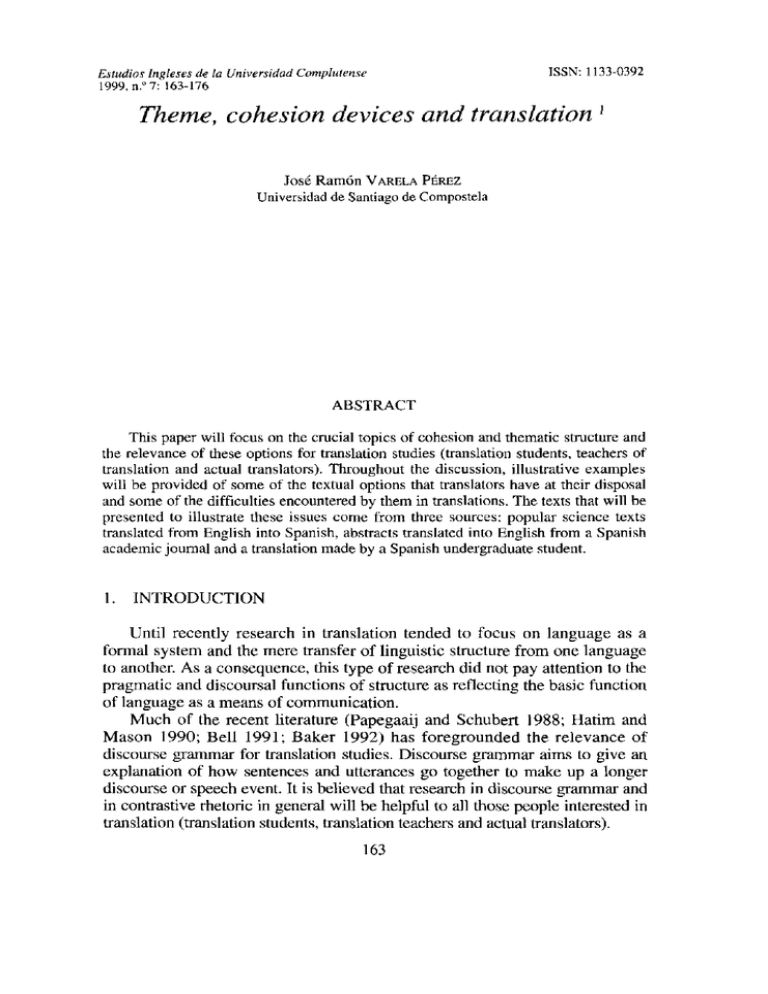
Estudios Ingleses de la Universidad Complutense 1999, nY 7:163-176 ISSN: 1133-0392 Theme, cohes ion devices and transiation’ José Ramón VARELA PÉREZ Universidad de Santiago de Compostela ABSTRACT This paper will focus on the crucial topies of cohesion and thematic structure and the relevance of these options for transiation studies (transiation students, teachers of transiation and actual translators). Throughout the discussion, illustrative examples will be provided of sorne of the textual options that translators have at their disposal and sorne of the difficulties encountered by them in translations. The texts that will be presented to illustrate these issues come from three sources: popular science texts transiated from English into Spanish, abstracts transiated into English from a Spanish academie joumal and a transiation made by a Spanish undergraduate student. 1. INTRODUCTION Until recently research in transiation tended to focus on language as a formal system and Ihe mere transter of linguistie structure from one language to anoten As a consequence, this type of research did not pay altention lo the pragmatic and discoursal functions of structure as reflecting the basic funetion of language as a means of communieation. Much of the recen literature (Papegaaij and Schubert 1988; I-Iatim aná Mason ¡990; Belí 1991; Baker 1992) has foregrounded the relevance of discourse graramar for transiation studies. Discourse grammar aims to give an explanation of how sentences and utterances go together lo make up a longer discourse or speecb event. It is believed that research in discourse grammar and in contrastive rhetoric in general will be helpful to ah tose people interested in transíation (transtation students, transiation teachers and actual translators). 163 José Ramón Varela Pérez Theme. cohesión devices nad transiation Ihe present paper concentrates on te relevance of cobesion and tbematic eboice for transíation studies, as well as on te ways in whicb botb professional and unskilled translators of English and Spanish deal witb [bese resources. Ibree types of tex[s will be provided [o iflustrate tese issues: a) [bree popular sejence tex[s transiated from English into Spanish by professional transla[ors; b) ayo abstracts [aken from a Spanisb academie journal dealing witb classical studies, rendered mío Engiish by [be autbors of [he anides tbemselves, possibly witbout [he belp of native Englisb speakers 2; e) a [ex[ transiated from Englisb luto Spanisb by a Spanisb undergraduate student. The aim of our analysis here 15 [hus merely descriptive. More detailed corpus-based studies, based on translations of specific types of iexts, are likely [o quantify precisely tose problems most commonly found by skilled and unskilled translators in dealing witb [hematization and cohesion devices, althougb that type of work is beyond [he seope of [he presen[ study. Transiation is a process primarily realized on texts, rater tan on lexical items or sentences. Por Hafliday and Hasan a [ex[ is “any passage, spoken or written, of wbatever length, [bat does form a unified wbole” (Halliday and llasan 19’76: 1). Furthennore, a íext can be defined as a structured series of units (sentences aud paragrapbs) linked toge[her by specific semantie relationships wit te aid of te co-tefl and tbe wider contex[ of situation. Por a text [o bave communicative value it must have certain textual properties usually known as [exture or textuali[y (Halliday and Hasan 1976: 27, 229; Beaugrande and Dressler 1981: 3; Ha[im and Mason ¡990: 192-93; BeIl [991:149-50). These properties mean tba[ (a) A text must belong to a particifiar genre and to a spec¡fic [ext—type. Genres are conventionalized forms adopted by [exts in differen[ social con[ex[s: jokes, advertisements, novels, newspaper headílues, e[c. Text-[ypes reflec[ he main rhetorical funetion of a text: descriptive, argumenkilive, persuasive, informarional, etc. (b) A tex[ mus[ have a thema[ic and information s[ruc[ure; it mus[ reflect [he setection of op[ions from the Theme aud information systems. (e) A [efl mus[ be coheren[; [bis necessary feature for [exis may be signalled by explicit means (cohesion) or not. The choices in (b) and (e) (as regards cohesion) are subject [o languagespecific norms. English and Spanish, br instance, differ in the way [hey encode te selections in the Theme system and in [he way tey make use of cohesion devices. Relationsbips be[ween sen[ences and paragraphs canno[ be accounted for in [erms of constituent structure (Halliday and Hasan 1976: 7). Strictly speaking, themaúcity and cobesion are not graminatical notions; tbey have notbing to do wi[h wbether a given sequence is grammatical, bu[ wit acceptability and Estudios 0Ingleses de la Universidad Complutense 7: 163176 1999, n. 164 Theme, cohesión devices and transloiion José Ramón Varela Pérez naturalness. Thus, sentences in a ste[cb of language might be gramniatical bu[ no[ constitute a unifled accep[able text. This is sbown by te foltowing muchquo[ed example by Halliday (1978: 134): (1) Now comes [be Presiden[ here. 1[’s [he window he’s s[epping [hough lo wave [o the crowd. On bis vic[ory bis opponen[ congra[ulates him. “Gentiemen and jadies. That you are confiden[ in me honours me... Here, aI[hough each one of [he sentences is syntactically well-formed, neiter of tbem seems to be properly related to Ihe otber ones. It is only by means of cobesion devices and options in te Theme and information system tba[ translations may tum ou[ to be nol only equivalent but also acceptable. The unna[urainess and lack of cohesion of many transla[ions mus[ be accounted for by [bese devices and no[ only by lexical and syntactic equivalence. 2. THEME, METHOD OF DEVELOPMENT AND THEMATIC PROGRESSION One way of exploring Ihe organizadori of information in texts is to suggest tha[ a sentence in a piece of language does no[ come ou[ of te blue but builds on [he previous sen[ence or seníences [o carry its meaning forward (Halliday 1985: 38). From tbe point of view of [ex[uat meaning, clauses consis[ of two segmenís, Tbeme and Rheme. The Theme is realized grammatically by [he inilial element in [he clause, te starting-point of te clause as a message, í. e. tha[ element wbich te clause is about (bu[ cf Downing 1991 for a different view on Theme). Ibe Tbeme has [wo main func[ions: fxrs[ly it acis as a poiní of orien[ation of [he sentence by connec[ing back [o previous s[re[ches of discourse (Themes or Rbemes) and tbereby main[aining a coherent point of víew. Secondly, [he Iheme acts as a poin[ of departure by presen[ing [he second segment of [he sen[ence, [be Rbeme. Tbe Rheme contributes [o te goal of discourse; i[ usually represenis te non-recoverable new information tha[ the writer or speaker wan[s to convey. Following Mauranen’s proposais (Mauranen 1993a: 121), we migb[ subdivide Tbemes in English mio ~o subcategories: orienting Themes (connec[ors, adverbials, complemen[s, modal clauses, reporting clauses...) and topical Tbemes (cf also Downing 1991; Gómez González 1996). Tbe following example illustrates how [he aboye scbeme is applied [o English sentences (Tbemes are marked in boid): (2) Nevertheless, when scientists debate Ihe validity of competing theories in medicine aud biology,] ORIENTING [theyj TOPICAL often ci[e animal s[udies as evidence. 165 Estudios Ingleses de la Universidad Complutense 1999, nY 7:163-176 José Ramón Varela Pérez Themne. cohesión devices and transiation The overalí choice and ordering of Themes and Rhemes plays a cmcial role in organizing a tex[ and in providing a point of orienta[ion for a s[re[ch of language. Thematization is important as te transíator has [o respect [he source [ext alTangemen[ of information in terms of given/new information and also in [erms of te desired tbematic prominence, aH of which is grammaticalized in distinct ways in te source and in te target language (Ha[im and Mason 1992: 220). Thema[ic progression in English texis is usually maintained in [ransla[ions in[o Spanish because basic word-order in English (SVO) can be easily kept in Spanisb. Sometimes lexical or gramma[ical adjus[ments are needed [o render the Spanish version more natural, mainly because word-order in Spanish aud in o[her languages is deterruined by pragmatic, discourse and s[ylis[ic reasons (oid/new information, ThemelRbeme, end-weigh[, presenta[ive order, e[c.) wbereas word-order in English has become grammaticalized and fixed (Hickey 1997: 31). Tbis tension between [he gramma[ical and communica[ive func[ions of [hematic s[ructure can be resolved by a varie[y of s[ra[egies such as voice change, change of verb, nominalization, extraposi[ion, etc. (Baker 1992: ¡6772). Tbus, thematic structure should be preserved in transla[ions only if the source [ex[ word order can be retained in ibe [ransla[ion; o[herwise grammatical, lexical and other readjus[men[s are needed. A case in poin[ is [he passive voice; when [he passive is used in English [o maintain [hematic con[inuity by placing [he objec[ in Theme position, i[ is commonly rendered mio Spanish as a se-passive construction or as an active cons[ruction wi[h change of word order (Colina 1997: 132). Ihe la[ter is [he case in the transla[íon of (3). [aken from Scient¿fic American, a popular science magazine. The Spanisb version of tbis journal is called Investigación y Ciencia ~: (3) Contrast [he way cocaine works with [he way heroin works. Heroin binds [o a neurotransmi[ter receptor... Heroin can be stopped by inactive, dummy compounds (such as naltrexone) tha[ bind lo [he same recep[ors and [hereby block heroin’s access to [bern. La forma de ac[uar de la cocaína contrasta con el mecanismo empleado por la heroína. Esta se une al receptor de neuro[ansmisor... Podemos detener la heroína mediante compuestos sustitutivos inactivos (como la nalirexona), que se unen a los mismos receptores e impiden así que la droga acceda a ellos (PT). Tbematic s[ruc[ure is connec[ed [o [wo related concepts: me[hod of developrnent and thema[ic progression. Tbese [wo concepts are useful in explaining methods of organizing and developing informalion in different íypes of íexts. Tbe metod of development in a paragrapb is indicated by [he information contained within [he topical (“ideational” in [he sense of Halliday) E~ludios Ingleses dela Universidad Complutense 1999, nY 7: 163-176 1 66 José Ramón Varela Pérez Theme, cohesion devices and transíation Themes of ah [he sentences of tbat paragraph (Fries 1981: 20). Ib [be Themes of [he majority of te sentences in a paragraph refer [o one semantic fleid, ten tba[ seman[ic field will indicate [be me[hod of developrnent of [be paragraph. For instance, travel broehures have been found [o display a high percentage of place adjunc[s in thema[ic position because, in tbe context of ¡nivel, location provides a natural point of orientation to organize [be text as a wbole. The transla[ion of [hese brochures sbould [ben respec[ bat semau[ic continui[y of thema[ic choices so that reader’s atten[ion does no[ wander from te topie of a paragraph (Baker 1992: 126). As this is easily conveyed in translations, no mis[akes have been found in [he tex[s examined here as regards te method of development. Ihe other important concep[ connected to thematic structure is [ha[ of [hematic progression, which is de[ermined by how Ihemes can be rela[ed [o previous Themes and Rhemes by rneans of different seinan[ic links: identi[y, synonymy, par[ial identity, contrast, specification, etc. (Mauranen 1993b: ¡03). In [ex[s. various rhetorical pat[erns of [hematie progression can be created (Dane~ 1974: 118-120): (a) Simple Linear Progression (typical of exposi[ory-argumenta[ive [ex[s), where eacb Rheme becomes [he Theme of [he nex.t utterance: TI—* Rl II 12 1=RII —~ R2 1/ T3 [—R2] —> R3; (b) Thematic progression with a cons[ant Theme ([ypical of narrative-descrip[ive [exts), where [be Tbeme of [he first clause becomes the Iheme of [he following clause: T1—*RI II TI—*R2 1/ T1—>R3; (c) Tbematic progression wi[h a sph[ Rheme, where [he Rbeme of [he second clause is spli[ in[o [wo elements, eacb being [aken as a Iheme in [he next sentences: TI —4 Rl II T2 [=R1I —* R2 II T3 [=RII R3; (d) Thema[ic progression wi[h Derived Themes, wbere Themes are derived from a Hyper[beme [TI: [TI (=Tl, 12, 13)1/TI —*RI //T2—~R2//T3 —*R3. According Lo Baker (1992: 128) transla[ors are faced wi[b two possibilities in dealing witb [hema[ic progression. If [he elemen[s placed in thema[ic position in [be source text can easily and na[urally be placed in Iheme posi[ion in [be [arget language, [ben [he ¡netod of development of [be [wo tex[s wiIl be very much alike. But if te tema[ic pat[eming of the source [ext cauno[ be easily accommodated iri [he Iheme, [hen [he [ransíator must abandon it, bearing in mmd [bat the [arget version should have a meted of development and con[inui[y in i[s own rigbt. One of [he main mistakes tbat un[rained transla[ors mate is lrying to impose [he [hematic pat[erning of one lauguage on [be structure of te o[her Several types of errors connected wit tema[ic progression can be found in transla[ions from English into Spanish (Fernández Polo 1995: 259-26). One source for mistakes appears wben [here is not a clear connection be[ween te Ibeme in a sentence and ibe Theme or Rheme of a preceding one. Ihis does not allow information to progress smootly, and [he reader can have problems —> 167 Estudios Ingleses de la Universidad Complutense 1999, nY 7:163-176 José Ramón Varela Pérez Theme, cohesión devi ces and transíation in interpreting what he or she reads, as can be sbown in [be following example. Bo[b te source text and i[s transíation mio Spanisb were [aten from a popular science text and bave been commen[ed on by Fernández Polo (1995: 259): (4) Guanine consists of a combination of five carbon and four nitrogen a[oms, arranged in[o [wo adjacen[ rings. (Each carbon and nitrogen in the rings is assigned a number from one to nine.) Esta purina consta de una combinación de cinco á[omos de carbono y cua[ro de nitrógeno, dispues[os en dos anillos contiguos. (Se asigna un número del uno al nueve a cada carbono y a cada nitrógeno de los anillos.) In tbe English text we bave a thematic progression wi[h a simple linear pa[tern of developmen[. The Theme of [he seeond clause (Each carbon and nitrogen in tite rings) cbooses as [he point of departure an element recoverable from [he Rbeme of [he previous clause (carbon and nitrogen), thus providing a íransi[ion between [he information presented in [be [wo sen[ences. However, in [he Spanish version ibe given element is placed in rbematic position and [he reader’s [ask of interpre[ing [bis pafl of [be text is made ra[her difficult. Sometimes transla[ors bave problems in using Tbeme and Rbeme to give Ihe necessary empbasis [o a piece of information or [o set up expec[a[ions in [he reader abou[ wba[ is [o come in [he discourse. Tbe Iat[er is [he case in [he Spauish rendering of (5). [aten from Scientíflc American and Investigación y Ciencia respectively: (5) There is no question about it: [he number of animais used in laboratory experiments is going down. (...) indiscutiblemente, en los laboratorios es[á disminuyendo el número de animales de experimeníación. (...) (1W) This is tbe fxrst sen[ence in the in[roduction [o an anide on ihe benefrts and disadvantages of using animals in scientific research. The anide s[arts as if one was already in ihe middle of it. The first sentence in [be source text may be divided mio two utierances; te first u[terauce appears Lo presuppose much of wbat has gone before but in fact [be reader has [o supply tbe referent for it, which refers catapborically Lo ihe whole of [he nex[ urterance. In [bis way, by having to search for tbe interpretation of ihe it, [be in[eres[ of ihe reader is emphatically engaged. Tbus, tbe first u[terance acts as a poiní of departure for tbe second utierance (tite number ofanimais used in laboratory experiments is going down). It signals what tbe article is abou[ (animal tes[ing in research experimenis). On [he o[her hand, none of tese effecis have been retained in [be Spanisb version. The two infonnation uni[s bave been rendered as a single one. The opening evaluative adverbial (indiscutiblemente) is no[ powerful Estudios Ingleses de la Universidad Complutense 1999, nY7: 163<76 168 Theme, cohesion devices and transíation José Ramón Varela Pérez enough io set [be Lone for tbe ensuing argumentation and ihe prepositional phrase as marked Tbeme (en los laboratorios) does not seem to act as a proper poin[ of departure of ihe tesis defended in [he article nor is tbe interesí of 11w reader engaged as i[ was in [be English version. Anoiher iypical error occurs when retrospeclive Themes (orienting Themes in [he terminology used aboye), which incorporate imporianí links [o previous clauses, are elimina[ed in [he process of [ransíation. The following is [he beginning of a paragraph iaken again from Scient¡flc American and i[s Spanisb version, Investigación y Ciencia: (6) In addition lo medical researcb, animais are also used in [he laboratory [o [est [he safe[y of drugs and o[her chemicals. Se recurre a la experimentación animal para comprobar la inocuidad de fármacos y otros produc[os químicos (VI’). The Theme of [be Englisb senience, realized by a Prepositional Pbrase, contains informa[ion linking back Lo [he previous paragraphs dealing wi[h [he use of anirnais in studying human diseases. This connec[ion is lost in the Spanish sen[ence and [his mates reading much more difficul[: the transilion be[ween [he [wo uses [be use of animais in medicine (research and testing) is [hus omi[ted. Some[imes the opposite procedure is taken, and the transíator has to make [he connecíions beíween previous Tbemes aud Rbemes much more explicit. This so-called “explicita[ion hypo[hesis” (Blum-Kulka 1986: 19) would accoun[ for [he exis[ence in irauslations of an observed cohesive explici[ness from [he source language [o [he targe[ language regardless of [he differences between [he linguistic and textual differences between languages. In the following ex[ract taken from [he same popular science journal aboye, [he [ransla[or has considered i[ necessary [o include in te Theme of [he second clause of the paragraph (en esta prueba) information picked up from the Rheme of the previous sen[ence. fle transi[ion be[ween [he two sentences is made smoo[ber, [bus helping [be readers Lo make up for their limited knowledge of te subject matter under discussion: (7) Anotber unpleasant procedure is the LDSO [es[ for vaccines. Experimental animals are vaccina[ed againsí a disease; tbey and a control group are [hen exposed [o i[. Otro procedimiento desagradable es el del test LD8O para las vacunas. En esta prueba, se vacunan los animales de experimentación conira c¡er[a enfermedad, a la que se exponen los animales del ensayo y un grupo de control (PT). Finaily, someíimes new informalion is [aten as [he meibod of development and placed in Tbeme posi[ion, which leaves the Rheme emp[y of con[en[ 169 Estudios Inglesesde la Universidad Complutense 1999, nY?: 163-176 José Ramón Varela Pérez fleme, cohesión devices and transiation (Ven[ola 1994: 268; Ventola 1997: lOO). Tbe la[ter is te case in (8). an extrací [aken from an abstrac[ in an academic ar[icle dealing wit classical siudies ([he Themes in [he firs[ senience are rnarked in boid): (8) El autor discute la ubicación del fr. 113 E. dentro del hipotético orden de los fragmentos de Recate. No es probable, contra la opinión más común, que se [rate de una simple indicación temporal. Y sugiere, en cambio, como más razonable su adscripción, con la mención de Venus como elemento comparativo, al pasaje en que la anciana Hécate narra la ruina de su próspera casa. ¡u tbis paper ibe position of It 113 H. witbin tbe bypotbetical order of tbe fragmenis of Hecate is discussed. It is arguable [bat this fragment might be, as it is usually defendcd, a mere time reference. In the author’s opinion it is suggested [bat i[ may belong. wiffi [he mention of Venus as a comparative term, ro ihe passage in which [he oid Hecate narrates the decay of her prosperous house (NPT). In [he Englisb version, ihe firs[ sentence in [he abs[ract violates welIknown principIes of Englisb word order, whicb prefers placing focal elements (end-focus) and syniac[ically heavy elemenís (end-weight) [owards ihe end of the clause. Whereas the Therne is realized by a complex nominal group, wbich makes [be sentence difficul[ Lo read, the Rbeme is ra[her trivial and simple. Readers expect someihing new [o be said about the Theme in Lhe Rheine pan of the sentence, not merely [be reporting process (is discussed). This type of mis[ake was common in ihe [ransla[ion of [he abs[rac[s, which were undoubtedly [ransíated by [be authors of [he articles themselves. 3. OTHER TYPES OF TEXTUAL COI-ILSION A distinc[ion mus[ be drawn be[ween cohesion and coberence. Coherence can be defined as [be universal se[ of procedures wbich guaran[ee concep[ual conneciivi[y such as relaíions of cause-effec[, problem-solu[ion, [emporal sequencew -dr-; (-Ecaugrande -and- Dressler 198 l: 4.7; Hatim-and--Mason 1990’ 195). For coberence [o be maintained readers must relate what Lhey read to iheir knowledge of te world. Cohesion, on te other hand, is te indication of coherence by linguis[ic means. From [bese definitions we can reach a conclusion: a given tex[ can be cohesive a[ te tex[ual level and, nevertheless, lack conceptual coherence. Such is [he case of (9): (9) He took a tin-opener. He opened a tin. He went to the kitchen. Tbe sequence of [hree sen[ences is fully cohesive because [he coniinuity of reference is maintained througbou[ hy [he use of [he tbird person pronoun Estudios ingleses de la Universidad Complutense 1999, n.~7: 163-176 170 Theme. cohesión devices and transíation José Ramón Varela Pérez “he”, and as far as [ense is concerned we could even mate sense of [he [hree clauses as a sequence of pas[ evenis. However, this ordering of events does no[ correspond tu our common knowledge of a sequence of events in [be real world. Thai is why ihe text can be cohesive wbile s[ill remaining incoberen[. For our purposes here we shall concentrate our at[en[ion on the linguislie concep[ of cohesion encoded by lexical and grammatical means, and leave coberence rela[ions aside. As defined by Halliday and Rasan (1976: 10): “Cohesion refers to [he range of possibiliiies tat exist for linking sometbing wi[h wha[ has gone before.” In [bis sense, cohesion is language and textspecific. Reference, subs[itution, ellipsis, conjunclion and lexical cohesion are [he devices identified by these [wo researchers for establishing cohesive links. Reference and subs[i[ution are used by wriiers [o allow readers [o trace par[icipants, [hings, events, etc., in a [exí or in [be con[ex[ of situation by means of chains of reference. Once a new par[icipan[ is mentioned in a texí [he writer must keep track of ihe participant by attenuaied forms sucb as defini[e anides and pronouns (l-Ialliday 1985: 311; Ventola 1992: 277ff; Ventola 1994: 282). Each language has i[s own preferences and norms for cer[ain types of reference as well as specific [endencies being sensitive to differen[ tex[ types (Mauranen 1990: 239; Baker 1992: 183). It has been shown, for instance, thai academic texis in English use more lexical repetition than similar Spanish [exis belonging to [he same register and genre (Aznar Mas, Gil Salom, Jaime Pas[or and Mon[ero Fle[a 1989: 30). Spanish, on [he other haud, is said to favour pronominal references or deic[icals [o connecí back Lo previous referenis. As the English system of reference makes few dis[inctions as regards gender, number or verb agreemen[, lexical reiteration is [be norm in contexis of ambigui[y in wbich Spanish prefers devices sucb as subs[i[ution, ellipsis or collocation. This sta[e of affairs is cominon in iransla[ions of popular science [exis. For instance, in (10) tbe compound animal research (repeated three [imes in [he source [en) is rendered twice in Spanisb witb atienuated forms such as la experimentación and esta confroversía: (10) There is also much room to challenge the benefits of animal research aud much room [o defend such research. la the nex[ few pages, you will find a debate between opponents and supporters of animal research. It is followed by an article thai seis ou[ he his[onical, philosophical and social contexí of the animal research controversy. We leave it [o you to judge [he case. Hay razones para poner en [eta dc juicio los beneficios de la experimentación y razones para defender [al investigación. En las siguientes páginas se abre un debate entre oponentes y defensores de la experimentación animal, y, a con[inuación, un artículo en el que se expone el contexto histórico, filosófico y social de esta controverw,a. Juzgue cada lector por si mismo el caso (Pl”). 171 Estudios Ingleses de la Universidad Complutense 1999, ni’ 7: 163-176 José Ramón Varela Pérez TI.eme, cohesion devices and transíation Velimas-Lehio (1991: 179) has noted that [here exist two opposite reasons for cohesion flaws in transtations. Firsí of alí, sorne cohesion devices presen[ in [be source [ext may nol be reproduced in [he [ransíation. Secondly, there may be undue transfer wi[h atíention not paid Lo the differences in usage between te sonree and [he targei text. Unskilled iranslaiors, for insianice, are prone to mate use of reference marking (article usage, pronouns, etc.) in an inconsistent way. Fernández Polo (1995: 258) comments on [he main problems wiih reference and substitution tbat can be found in translations. Basically thcse problems have to do witb: a) Failing to assign [be correc[ referent [o a pronominal form. b) Failing to es[ablish [he connection beiween two differen[ expressions referring to [be same en[ity by means of synonymy or hyperonymy. c) Failing Lo mate clear wbe[ber two similar forms refer to tbe same or two differen[ entities. Text (11) is a [ransíation from English into Spanish carried ou[ by a universi[y studen[ of Englisb Philology at [he undergradua[e level. Notice the ambiguous status of [he ellipted subjec[ fonn of the verb estaba: it is not clear in iLe [ransíation whether estaba refers [o tbe car or to [he first person protagonis[ who is telling te story: (II) Well, 1 must go now—I’ve got togo and collect [he car fi-orn the garage. ¡ was out in [he middle of nowhere yes[erday, when it broke down for no apparent reason. (...) Bueno, ahora me tengo que ir, tengo que ir a recoger el coche del taller. Ayer estaba en medio de ninguna parte cuando se estropeó sin razón aparente. (...) (NPT) It has been pointed out thai te in[erplay of [be systems of reference aud Theme sbould be srnooth so that arubiguities do no appear in texts (Ventola 1994: 2811-282). For example, tbe reader of [he Spanish version in (12), from Investigación y Ciencia, migbt not be able Lo determine wbo [he subject (and Tbeme) of [he las[ sentence might be: (12) [1] Animal experimenters often defeud [heir work with brief historical accounts of the supposedly pivotal role of animal data in past advances. [2] Sucb interpretations are easily skewed. [3] For example, proponents of animal use often point to [he significance of ai~imals [o diabetes research. III Quienes son partidarios de los ensayos con animales acostumbran reforzar su defensa con breves alusiones históricas del supuesto papel central del pasado. [2] Se trata de de interpre[acaiones sesgadas. [3] Recuerdan, por ejemplo, su interés decisivo en la investigación de la diabetes (Pl”). Estudios Ingleses de la Universidad Complutense 1999, nY?: 163-176 172 Theme, cohesion devices and transíation José Ramón Varela Pérez Whereas in [be source text, sentence [3] explicitly picks up [be Theme of [he firs[ sentence (animal experimenters / for example, proponents of animal use), [be Spanish rendering of [3] avoids [be repetition of tis point of departure. The referent of recuerdan is nol made clear: [be reader migbt process [bis verb as referring Lo te Rbeme of te previous sentence (interpretaciones sesgadas). In order [o process tis 1aM sentence correctly, [be reader will bave Lo make a mental backtrack, making a referential link back from recuerdan in [3] to acostumbran in [1]. Another importan[ cohesion device is provided by sentence connectors, which function as explicii markers of [be seman[ic rela[ions (addi[ion, Lemporal progression, contrasí...) exis[ing between sen[ences and between textual units such as paragrapbs and sections in a texí. It bas been found thai English prefers [o present information in relatively sinaí] cbunks and to signal [he relation between chunks in unambiguous ways, using a variety of conjunctions [o mate semantic rela[ions between sentences and paragraphs explicit. What happens in translations froin English into Spanish is that many conjunctions are either omi[ted or misinterpreted and [his no doub[ may cause an ‘mportan[ loss of in[elligibili[y. Recent s[udies on contrastive rbetoric have demonstrated thai whereas English lies at tbe higber level in a scale of explicitness, Spanish is probably one of [bose languages and cultures halfway be[ween English and olber so-called “reader-responsible” languages sucb as Japanese of Korean, and [herefore less explicit [ban English in such cohesive devices as reference and textual connectors (Fernández Polo 1995: 262). Texí (13) is again [aken from [be transíation of an abstract taken from [he research anide dealing wi[h classical s[udies. Notice tbat ihe connectors en el primer caso and en el segundo (which should bave been rendered as in tite former case and in the latter case) bave been erroneously rendered as firstly and secondly: (13) El tema del presente artículo es algunos aspectos puntuales sobre la “forma agrorum” que hasta ahora no han sido tenidos en cuenta o que se han interpretado erróneamente. En el primer caso está la naturaleza semántica del vocablo “forma” y de sus sinónimos en la literatura gromática; en el segundo, el sentido que las expresiones “ex forrna”, “in formis” o “secundum formain” tienen en las inscripciones en las que aparecen. This paper is an analysis of sorne unhandíed questions and erroneous interpreta[ions about [he “forma agrorum”. Firstly, the rneaning of [he [errn “forma” and its synonym jo the landsurveyor’s works; secondly, [he sense of the expressions “ex forma”, “in forrnis” or “secundum formain” in [he inscriptions in which tese are employed (NPT). 173 Estudios Inglesesde la Universidad Complutense 1999, nY 7:163-176 José Ramón Varela Pérez 4. Theme, cohesion devices and transíation CONCLIJSiON The theore[ical study of transíation carried out by discourse analysis and [he practice of transíation must centre not only on leveis of lexis and grammar bu[ also on aspects of cobesion and [hematic structure. Studies dealing with contrastive rhetoric are needed to show how Spanisb, Englisb and other languages differ in [erms of reference inarking, [bematic progression, [be use of textual connectors and so on (Blum-Kulka 1986: 23). Translators should at least be conscious of tbe fact [bat translations must not proceed clause by clause, more or less translating each piece of language at a time (Ventola 1992: 233). Tbe previous discussion sbould have a bearing on [he teaching of transíation [heory and the practices of translating tex[s. Transíation theoreticians have s[arted to acknowledge [bat since the writer of a text and its transíator belong to different cultural and linguistic systems not normally sharing te same textual features, translations should be compatible with target language norms and witb the generic conven[ions of au[bentic target language texts. As Vehnras-Lebto (1991: 171) puts it “transla[ions need tobe not only equivalent, but also acceptable aid natural”. NOTES The research reponed in this article was funded by the Galician Ministry of Education (XUGA 20401A97). TIiis grant it hereby gratcfnlly acknowledged. 2 fue, <o the illustrative. nature of this paper and te pro<ect the identity of the writers, <he sources of the academic examples will not be mentioned. Professionally transíated texts are marked by <he syrnbol (Rl’), non-profestional rranslations by (NPT). Tbe remaining illustrations are not from the corpus. The three popular science articles quoted in tbk papcr are: Mukerjee, M (1997). Trcnds In animal research. Sciennfic American. February, 1997: 70-77; Barnard. N. D. and 5. R. Kauftnan (1991). Animal research is wasteful and misleading. Scient,flc American. February, 1997: 64-66; Landry, O.W (1997). Immunotherapy for cocaine addiction. Scienti/ic American. February, 1997: 28-31.The Spanish versions of these articles are: Mukerjee, M (1997). Tendencias de la investigación animal. Investigación y Ciencia. Abril, 1997: 74-83; Barnard, N. D. and 5. R. Kaufman (1997). Una investigación despilfarradora y engañosa. Investigación y Ciencia. Abril, 1997: 66-69; Landry, D.W (1997). Inmunoterapia contra la drogodependencia. Investigactión y Ciencia. Abril, 1997: 46-49. Universidad de Santiago de Compostela Facultad de Filología Inglesa. Avda de Castelao s/n. Santiago de Compostela [email protected] Estudios Ingleses de la Universidad Complutense ¡999, nY 7: 163-176 174 TI.eme, cohesion devices and transíation José Ramón Varela Pérez RFFERENCES Aznar Más, L.; Gil Salom, L.; Jaime Pastor, A. asid Montero Flea, E. (1989). Algunos problernas en la traducción al inglés del lenguaje científico. Ed. J. C. Santoyo. Actas del XI Congreso AEDEAN. León: Universidad de León. 25-31. Baker, M. (1992). Iii Otiter Words. London: Rou[ledge. Beaugrande, R. de and Dressler, W. (1981). Introduction to Textlinguistics. London: Longman. Belí, R.T. (1991). Translation and Translating: Tbeory and Practice. London: Longrnan. Blum-Kulka, S. (1986). Shifts of cohesion and coherence in transíation. Eds. J. Howe and S. Blum-Kulka. Interlingual and Intercultural Communication. Ttibingen: Gunter Narr. 17-35. Colina, S. (1997). Syntax, discourse analysis, andtranslation. Babel 43: 126-137. Dane~, F. (1974). Functional sentence perspective and [he organisation of the text. Ecl. F. Dan5. Papers on Funclional Sentence Perspective. Prague: Academia. 106-128. Downing, A. (1991). An alternative approach [o Themne: A systemic-functional perspective. Word 40, nurnber 2, August: 119-143. Fernández Polo, J. (1995). Sorne discoursal aspects in the transíation of popular science texts from English into Spanish. Eds. E. Warvik, S-K. Tanskanen, and R. Hiltunen. Organization in Discourse. Proceedings from the Turku Conference. Anglicana Turkensia 14. 109-128. Fijes, P. (1981). On the status of [heme in English: argurnents from discourse. Forum Linguisticum 6:1-38. Gómez González, MA. (1996). Theme: topic ordiscoursefrarnework, Miscelánea 17: 123-140. Halliday, M.A.K. (1978). Lan guage as- Social Semiotics: Tite Social Interpretation of Language and Meaning. London: Edward Amold l-Ialliday, M.A.K. (1985). An Iníroduction lo Functional Grammar. London: Edward Arnold. Halliday, M.A.K. and Hasan, R. (1976). Cohesion in Englisit. London: Longinan. Hatim, E. and Mason, 1. (1990). Discourse and tite Transíator, London: Longman. Hickey, L. (1997). Keeping words in order: a pragmastylistic problem in transíation. Donaire 8: 30-36. Mauranen, A. (1990). Reference in academic rhetoric. A contrastive study of Finnish and English writing. Eds. A. Lindeberg, N. E. Enkvist & K. Wikberg. Nordic Researcit on Texí and Discourse. Abo: Abo Academy Press. 237-250. Mauranen, A. (1993a). Cultural Differences in Academic Rhetoric: A Textlinguistic Study. Frankfurt: Peter Language. Mauranen, A. (1993b). Theme and prospection in written discourse. Eds. M. Baker, G. Francis, and E. Tognini-Bonelli. Text and Technology.. Philadelphia: John Renjamins. 95-114. Papegaaij, E., aud Schubert, K. 1988. Texí Coiterence in Translataion. Dordrecht: Foris, Vehmas-Lehto, 1. (1991). Cohesion flaws in translations. Ed. 5. Tirkonen-Condit. Empirical Research in Transíation and Intercultural Studies. Ttibingen: Gunter Narr. 171-181. 175 Estudios Ingleses dela Universidad Complutense 1999, nY 7: 163-176 Theme, coitesion devices and transíation José Ramón Varela Pérez Ventola, E. (1992). Tex[ and reference. Eds. A. Lindeberg, N. E. Enkvist, and K. Wikberg. Nordie Researcit on Ten and Discourse. Abo: Abo Academy Press. 223-235. Ventola, E. (1994). Finnisb writers’ academic English. Functions of Language 1: 261293. Ventola, E. (1997). Thernatic development and transíation. lid. M. Ghadessy. Thetnatie Development iii Englisit Texts. London and New York: Pinter. 85-104. Estudios Ingleses de la Universidad Complutense 1999, nY 7:163-176 176
